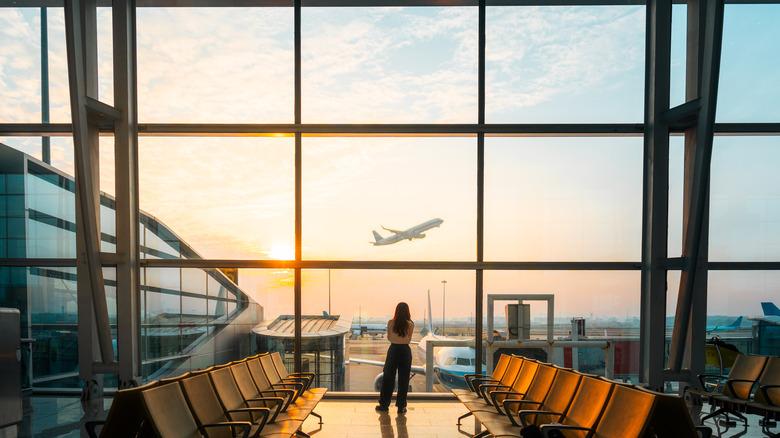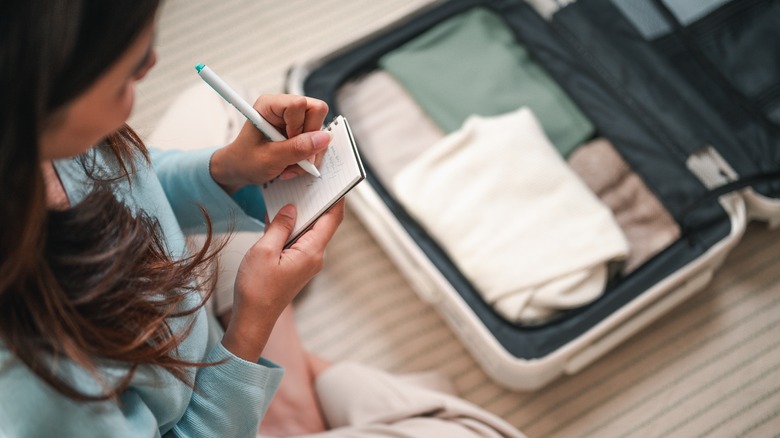Wearing This Type Of Clothing On An Airplane Isn't Just Uncomfortable, It's Dangerous
Air travel is built into the fabric of American life, with millions crisscrossing the skies daily. The U.S. Federal Aviation Administration overseas more than 45,000 flights each day, carrying about 2.9 million passengers to destinations near and far. From a quick hop to a neighboring state or a transatlantic journey over the pond, flying can spark a mix of excitement and stress.
The thrill of exploring new places or reuniting with loved ones often comes with a side of anxiety — navigating crowded airports, enduring long security lines, or sprinting to catch a flight just as boarding closes. Weaving through a packed terminal, with a carry-on bouncing behind you, heart racing as you just make it to the gate while hearing your name over the intercom, only to realize your outfit is working against you.
Choosing what to wear for a flight can feel like a puzzle. You want to look polished, perhaps even fashionable, while being considerate of the strangers seated inches away in tight quarters. Beyond appearances, the clothing flyers wear can impact health and safety during travel. Aviation experts caution that certain outfits aren't just uncomfortable, they're risky. Wearing the wrong attire on a plane can contribute to serious health issues, some with long-term consequences. From circulation problems to fire hazards, flight wardrobe choices matter more than one might think, and there are things you should think twice about wearing on your flight.
Clothing to avoid when flying
Not all clothing is flight-friendly, and some items pose surprising health risks. Tight fitting garments such as skinny jeans, leggings, or body con dresses, may seem like go-to choices for flying, but overly constrictive clothing can actually restrict blood flow. Constricting clothing, especially items that are tight around the waist, thighs, or ankles, limits blood circulation, and increases the risk of deep vein thrombosis (DVT).
DVT occurs when a blood clot forms in a vein, often during long periods of immobility, such as on flights lasting four hours or longer. These blood clots might even lead to life threatening complications like a pulmonary embolism if they travel to the lungs. In addition, reduced cabin pressure means less oxygen, a condition called hypoxia, which can slow blood flow and heighten the risk for clots.
Beyond circulation, certain fabrics also raise safety concerns. Many popular travel outfits, like leggings made from nylon polyester or spandex blends, are synthetic and highly flammable. In the rare event of a fire onboard, these materials can melt and create a hot, sticky substance that adheres to the skin, causing severe burns. Sandals, while convenient for security checkpoints, leave the feet exposed to unsanitary surfaces and cooler cabin temperatures, while offering little support for your feet when navigating a hectic travel day. Fussy accessories, such as belt buckles, or jewelry can complicate security checks or bathroom visits and add an unnecessary amount of stress to the journey.
Try these flight-approved choices for comfort and safety instead
To stay safe and comfortable, try opting for loose, breathable clothing that prioritizes health and function without sacrificing style. Fabrics like cotton linen or moisture wicking modal allow for better air circulation, keeping you cool even if sprinting through the terminal. Stretchy, elastic-waisted pants, or relaxed fit joggers strike a balance between ease and polish, and give your body room to breathe, reducing the risk of circulation issues.
It's best to aim for outfits that don't constrict anywhere in the lower extremities like the ankles, waist, thighs, or calves. Give your veins and arteries the best chance they have to circulate blood while in-flight. And try to avoid crossing your legs during the flight, as this can further impede blood flow. Layering is also key to adapting to unpredictable airplane temperatures.
A lightweight sweater or scarf can be added or removed as needed, giving you the ability to find comfort during waves of temperature fluctuations in the cabin. Closed-toe, supportive shoes are essential for long walks through the airport and maintaining healthy blood flow. Today's athleisure options make it easy to look chic while prioritizing practicality. Steer clear of complex outfits with intricate fastenings and ask yourself if you'd want to wrestle with your outfit in a cramped airplane bathroom. If you need help with a complete guide to packing, choose breathable, flexible, and non-flammable materials to arrive at your destination feeling as best you can both mentally and physically. Keep in mind these game-changing tips that will keep your clothes wrinkle free in your suitcase.


